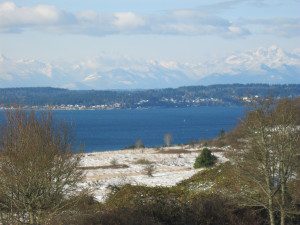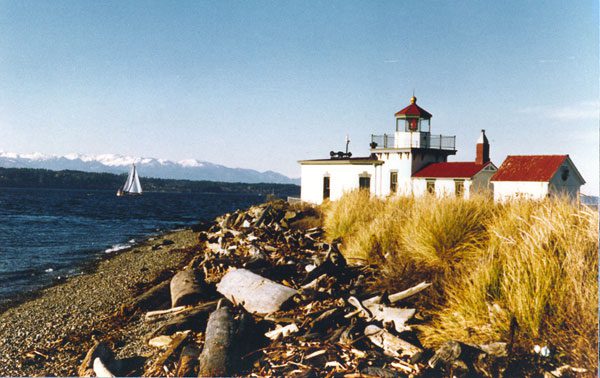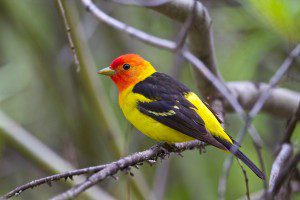Seattle Parks and Recreation Naturalist Anne Bentley has been working in Discovery Park for more than 25 years, and knows the area better than most. We interviewed Anne to learn her expert tips for getting the most out of a visit.
Q. Many visitors to Discovery Park head straight to West Point Lighthouse, but what are some other lesser-known places of interest?
In the northwest corner of the park, just off the north parking lot, there is a half-mile loop trail called the Wolf Tree Nature Trail. It has the largest collection of native plants in the park. The trail includes two beautiful streams, forested wetlands and some fairly large conifers and big leaf maples. It is a trail used in environmental learning classes and quiet contemplation, so we discourage jogging and dogs are not allowed. It is a great place for a walk anytime of the year.
The Wolf Tree Nature Trail has a spur trail to three reflecting ponds. These are human-made ponds retaining stream water from the hillside. The last pond or the lowest pond is largest with places to sit and picnic, birdwatch or enjoy the quiet.
The north section of the loop trail is a series of forested ravines. This is a great place to walk and see examples of the Pacific Northwest iconic forested landscape – large big leaf maples with licorice ferns growing on their branches, tall evergreens, pileated woodpeckers, salmonberry bushes with their pink blossoms in the spring and orange berries in the early summer.
The historic district is in the middle of the park, just west of the environmental learning center (ELC). The ELC has pamphlets for loan that include a district walking tour map. There is also an interpretive panel at the flagpole in the historic district that tells the history of Fort Lawton. Fort Lawton was the predecessor to Discovery Park. For those interested in military history, Pacific Northwest history, or architecture, the historic district is the place for you.
There is also a military cemetery in Discovery Park which holds a charm all its own. It is run by Fort Lewis and is open to the public. The surrounding landscape is serene and there are some interesting grave markers to discover.
The wetlands on the north beach are another unique place to visit in Discovery Park. Here a visitor can sit and watch birds, look for signs of beaver or river otter or enjoy the quiet and the colors.
Finally, the Hidden Valley Trail (HVT) is probably one of the least traveled trails in the park. It is the easiest trail to take from the beach back up to the other areas of the park. That is, easy, relative to the two other beach trails. It is still kind of steep. The HVT is full of plant life. It travels just to the east of the King County Wastewater Treatment Plant. It originates in the north bluff and drops you out by the comfort station closest to the beach. It has a couple of cascading streams at the top of the trail and nice glimpses of the Puget Sound through the trees all the way down to the beach.
Q. Where is your favorite place in the park?
That is a difficult question to answer. I love all parts of the park equally. I truly believe the entire park with its varied landscapes, diversity of wildlife and wildlife habitats, and multitude of stories is a treasure for residents of and visitors to the Puget Sound area.
Q. Why can Discovery Park be a fun place to visit even in the winter?
 There are so many reasons to visit Discovery Park in the winter. It is a great place to take a walk no matter what the weather. In general, it is always great to get outside and move. In addition, walking in the park helps renew the spirit. In the winter out in nature, everything may look bleak, dark and hopeless. With a closer look, though, little signs of new life are apparent – buds waiting to open, a tiny sprout emerging out of a maple seed. These are reminders of the cycles in nature. Spring always comes after the winter. These signs of hope and renewal may be helpful reminders for someone having a hard time in their life; reminders that things always change. And those visible signs of hope and renewal and change may nourish hope and renewal and change in a person’s psyche.
There are so many reasons to visit Discovery Park in the winter. It is a great place to take a walk no matter what the weather. In general, it is always great to get outside and move. In addition, walking in the park helps renew the spirit. In the winter out in nature, everything may look bleak, dark and hopeless. With a closer look, though, little signs of new life are apparent – buds waiting to open, a tiny sprout emerging out of a maple seed. These are reminders of the cycles in nature. Spring always comes after the winter. These signs of hope and renewal may be helpful reminders for someone having a hard time in their life; reminders that things always change. And those visible signs of hope and renewal and change may nourish hope and renewal and change in a person’s psyche.
Also, in the winter, with many of the leaves gone, the views are spectacular.
In general, Discovery Park is this accessible place for city folks to reap the benefits of a close encounter with nature, close to home, no matter what the season.
Q. What’s the most interesting creature you’ve come across in the park?
They are all amazing! It is the context in which I see the creature that makes it unique or special. There is nothing like seeing the bright yellow and red of a Western Tanager (bird) after all the gray of a Seattle winter. Seeing a Northern Alligator lizard basking in the sun is always a treat. I love the first garter snake I see in the early spring. It tells me winter is over. Hearing Pacific Tree frogs calling at dusk gives me a thrill because it means spring is on its way. And I could go on and on about the inter-tidal animals found on Discovery Park beaches – moon snails, sea slugs, sunflower stars just to name a few – colorful and exceptional sea creatures we are honored with glimpsing for short periods at low tides.
Q. What should people who have never been know before going?
People should know what stinging nettle is and how to identify it. We have a lot of it growing in the forested areas of the park. It does not kill. It may sting for a bit, though, if bare skin touches it. The folks at the ELC can help with identification or give more information it.
People also need to know that Discovery Park is a place to get out of the car and walk. There are no roads through the park that the public can drive their cars on. They can walk anywhere they want in the park. That is what makes Discovery Park such a unique place. It is a place to escape the turmoil of the city with its loud noises and cars; a place to relax, experience fresh air, tall trees, expansive vistas, and possibly view some wildlife.
Q. Where are some of the best viewpoints?
South Bluff, North Bluff, Daybreak Star Overlook, the Chapel, the flagpole in the historic district.

